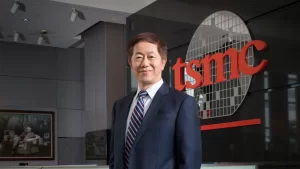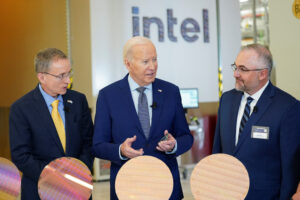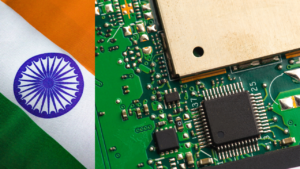The semiconductor industry is currently experiencing a significant boom in the United States, driven by technological advancements and the passage of the CHIPS Act. However, this progress is at risk due to a severe labor shortage in the industry.
According to a report by the Semiconductor Industry Association and Oxford Economics, there will be 85,000 new technical jobs in the semiconductor industry by 2030, but projections indicate that nearly 80% of these jobs may remain unfilled.
One of the critical contributing factors to this labor shortage is the industry’s reliance on foreign-born workers, and immigration hurdles are exacerbating the problem. In this blog post, we will explore the reasons behind the labor shortage, the role of foreign-born workers, and the urgent need for immigration reform to secure the future of the semiconductor industry in the United States.
The Labor Shortage Crisis in US Jobs
The semiconductor industry has been a driving force in the U.S. economy for decades, powering technological advancements in various sectors, including electronics, automotive, and healthcare. However, the industry’s rapid growth has created a shortage of skilled technical workers, threatening to hinder its expansion. The shortage extends to various roles, from semiconductor engineers to technicians, and it is projected to worsen in the coming years.
Read More: What is the Progress of Semiconductor Ecosystem in India in Last 2 years?
Foreign-Born Workforce and Immigration Hurdles in US Jobs
One crucial aspect of this labor shortage is the reliance on a foreign-born workforce. In 2021, approximately one-third of the semiconductor industry workforce was foreign-born. This diversity of talent has been a driving force behind the industry’s growth, bringing in expertise and knowledge from around the world. However, current immigration laws make it difficult for foreign-born workers to stay in the United States. This issue is further exacerbated by the fact that many foreign-born students who have come to the U.S. to pursue advanced degrees in semiconductor-related fields face significant challenges when attempting to secure employment and remain in the country.
Taiwan’s TSMC, a semiconductor giant, experienced delays in opening its Arizona plant due to a shortage of specialist workers, highlighting the impact of the labor shortage on even the biggest players in the industry. These delays can have far-reaching consequences, affecting supply chains and the United States’ position in the global semiconductor market.
Read More: How Huawei Could be a Winner in US Ban of Nvidia GPUs?
The Need for Immigration Reform in US Jobs
To address the labor shortage in the semiconductor industry, urgent immigration reform is required. Todd Schulte, president of FWD.us, a prominent immigration and criminal justice reform advocacy organization, has emphasized the critical need for reforming immigration laws. He highlighted that approximately 5,000 international students in the U.S. will graduate in the next academic year with advanced degrees in semiconductor-related computer science and engineering fields. Out of these students, at least 4,000 have expressed their interest in staying and contributing to the U.S. semiconductor industry.
The reform of immigration laws should align with the economic needs of the 21st century and address the specific workforce requirements of the semiconductor industry. This includes streamlining the visa process for skilled workers and providing opportunities for foreign-born students to stay and work in the U.S. These changes are crucial to maintaining the country’s leadership in semiconductor production and innovation.
Read More: China to Challenge ASML with a better technology than EUV
Status Quo in US Jobs
A major challenge in addressing the labor shortage in the semiconductor industry is work authorization. To illustrate, the U.S. government currently grants H-1B visas to approximately 65,000 qualified individuals each year, with an additional 20,000 slots reserved for those with master’s degrees. This cap has remained unchanged since 2006.
According to the American Immigration Council, when the United States Citizenship and Immigration Services (USCIS) receives more applications than the available visa numbers, a lottery system is used to select who can submit an H-1B petition. This selection process extends beyond the visa cap and is based on the USCIS’s estimations of how many employers will file petitions and gain USCIS approval.
Apart from the limited visa quota, other immigration barriers include slow processing times, complex regulations, extensive paperwork, and the high cost associated with sponsoring a work visa. A report from Envoy Global in March 2023 revealed that 94% of companies would be willing to sponsor foreign nationals for work visas if they encountered fewer challenges. Furthermore, 80% of companies had relocated employees to work remotely outside the United States due to difficulties related to obtaining visas.
Todd Schulte, the president of FWD.us, emphasized that the last substantial update to the U.S. legal immigration system occurred in 1990, a time that predates significant global shifts such as the end of the Cold War, the advent of the World Wide Web, and the emergence of economic powerhouses like China and India. The current immigration system is essentially a product of the 1950s and 1960s, with only minor modifications made in 1990, and it is not well-suited to the contemporary economic needs and global dynamics.
Read More: 4 Major Concerns to Secure Semiconductor Supply Chain as per Intel CEO
Boon for US economy
Reforming the U.S. immigration system wouldn’t just benefit the semiconductor industry; research suggests it would be a significant boost to the overall U.S. economy.
Boundless, an immigration tech company, reported that immigrants contributed more than $330.7 billion in federal income taxes to the U.S. in 2019, and their total tax contributions exceeded $492 billion.
Greg Wright, a nonresident fellow at Brookings and an associate professor of economics at the University of California, Merced, highlighted that in the past decade, the U.S. population has been growing primarily due to immigration. He emphasized that this stands in contrast to other developed nations, particularly in southern Europe and Japan, where populations are shrinking, and there’s a demographic imbalance characterized by an aging population. The U.S. has been relatively insulated from such demographic challenges, but this resilience is primarily attributed to immigration.
Between 2005 and 2022, the immigrant population in the U.S. expanded by nearly 30%, reaching over 46 million people, according to the U.S. Census Bureau. As of 2022, foreign-born Americans constitute 13.9% of the total U.S. population.
In contrast, native-born Americans are having fewer children, and many older individuals are retiring from the workforce, which further exacerbates the labor gap in the country. According to Wright, the issue is already becoming increasingly critical, and it’s becoming apparent that relaxing immigration policies may be the only viable option to address this demographic challenge.
Conclusion
The semiconductor industry’s labor shortage poses a significant threat to its continued growth and innovation in the United States. To address this issue, the country must enact immigration reforms that enable foreign-born talent to stay and contribute to the industry. The ability to attract and retain skilled workers is critical not only for the semiconductor industry but also for maintaining the nation’s competitiveness in a technology-driven global economy. By embracing immigration reform that aligns with the industry’s needs in the 21st century, the United States can secure its position as a leader in semiconductor production and innovation.








